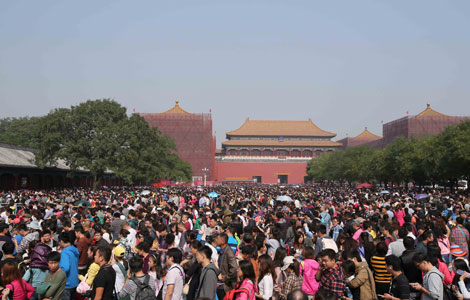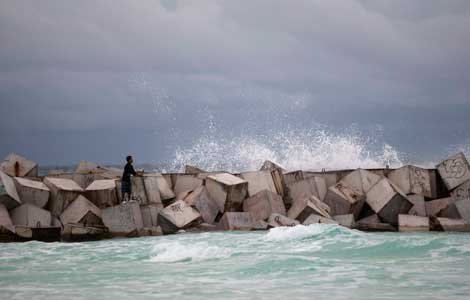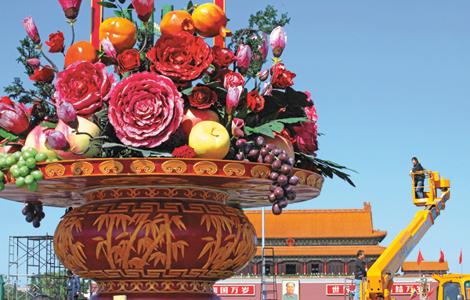Golden Week, or golden mess?
Updated: 2013-10-04 07:21
(Xinhua)
|
||||||||
|
 |
|
Tourists crowd at the Forbidden City in Beijing Oct 3, 2013. [Photo by Chen Xiaogen/Asianewsphoto] |
BEIJING - Highways turned into "free parking lots;" high-speed trains shuttled with the minimum possible intervals but still struggled to take the strain; armed police were summoned to help evacuate stranded crowds...
These are not screen shots from Hollywood blockbuster 2012 but rather a reality show currently taking place in China, where 1.3 billion people are on their 14th week-long National Day holiday.
Since the holiday kicked off on Tuesday, relatively comfortable weather across the country, toll-free highways, admission ticket discounts, and lower gas prices have combined to make this so-called Golden Week the best time for traveling.
At least that was the theory. But such miracles rarely happen when millions of minds think alike -- the hustle and bustle of crowds have been seen almost everywhere.
No other description allows better visualization of the situation than the Chinglish phrase "people mountain, people sea," as netizens re-branded Golden Week as "golden mess." FACTS AND FIGURES
98,000 -- The number of visitors received by the Summer Palace in Beijing on Wednesday as crowds flocked to catch a glimpse of a giant rubber duck installed by Dutch artist Florentijn Hofman.
The temporary exhibit, which has caused quite a buzz in China, was transferred to this former royal garden and residence prior to the Golden Week.
The park administration had to encourage local residents holding monthly or annual tickets to avoid coming to view the duck between 9 a.m. and 4 p.m. for the convenience of tourists from outside Beijing.
110 -- A record 110 pairs of high-speed trains have shuttled between Beijing and Tianjin every National Day since 2008, transporting more than 100,000 passengers daily. The trip between the two municipalities takes 33 minutes.
Major scenic spots in Tianjin, a coastal municipality neighboring Beijing, received 804,000 visitors on the first day of the National Day holiday.
4,000 -- Jiuzhaigou Valley, a World Heritage site famous for its colorful water pools, snowy mountains, deep valleys and forests, got into trouble on Wednesday when its shuttle buses failed to cope with a rush of 40,000 tourists.
More than 4,000 of them stranded in the valley were not evacuated until 10 p.m. on Wednesday. The whole traffic system was paralyzed after some visitors lost patience and tried to stop buses and get aboard, according to the valley administration which later apologized for insufficient measures.
12 -- The number of hours it took a Xinhua correspondent to drive 540 km (336 miles) from Harbin, capital city of Heilongjiang Province, to Shenyang, capital city of Liaoning Province, in northeast China, on October 1. Solutions
There have been many attempts to ease the problems. Under China's first Tourism Law, which came into effect on October 1, scenic spots are not allowed to receive tourists exceeding their capacities, and these should be made public.
Early warning mechanisms and group visitor reservation systems have been broadly introduced to make the best use of travel resources.
For instance, the administration of Mount Huangshan, another World Heritage site located in east China's Anhui Province, has a policy under which groups without reservations are not allowed entry at times when the attraction is approaching peak capacity.
With people traveling from far and wide to visit some scenic spots, it is hard to decline their often unyielding demand for admission. This intense demand has been identified as a key problem by people studying "Golden Week syndrome."
Possible cures, or at least palliatives, have been identified. Paid annual leave is one of them.
February saw the State Council, China's cabinet, announce a new program promoting domestic tourism. It says that a paid annual leave system will have been basically implemented by 2020, meaning all employers will be encouraged to subscribe to it by this point.
Both the program and the Tourism Law emphasize tourism and leisure welfare for ordinary people.
However, in reality employees who can take paid vacations are mainly from government organizations and state-owned enterprises. Most people working for labor-intensive and private firms face practical difficulties in enjoying the vacation. Their employers can simply decline their request.
Even if they are allowed time off, they could be skating on thin ice, with employers taking time off facing losing their jobs or promotion opportunities, such is the fierce competition for employment. It is rare to hear of employers not in some way punishing their staff for enjoying paid vacations. The week-long National Day holiday therefore becomes a "legal" time for these people to travel.
Travel is not only about time but also money. To encourage more people to travel, China introduced a policy of exempting highway tolls during holidays for the first time in October 2012.
One year on, passenger car drivers have been exempted 14.3 billion yuan (2.3 billion U.S. dollars) during four holidays with 20 days free of charge. Traffic has increased by 51.6 percent compared with previous toll-charged holidays, according to Liang Xiao'an, spokesperson of the Ministry of Transport.
Some have boxed clever to avoid the road rush. Cheng Zhengfa, who works in south China's Guangdong Province and drove back home to Wuhan, in central China's Hubei Province, said, "I departed before the toll-free day to save time. No traffic jam means less oil consumption, too."
Local administrations in east China's Jiangsu Province, and south China's Guangdong Province and Guangxi Zhuang Autonomous Region are gradually reducing or even exempting toll-gate fee for some highway sections. A nationwide campaign to standardize and regulate toll charging is also under way.
China's highway network takes in 90 percent of its medium-sized cities with a total mileage of 96,000 km (nearly 59,700 miles) as the end of 2012.
There is still a long way to go to make the highways free, says Wang Guohua, a professor of public administration with Huazhong University of Science and Technology in Wuhan.
Nearly 70 percent of the funding for China's highway construction has been bank loans, foreign investment, and social capital. The government's financial input alone was far from enough given the situation that transportation in many remote and less developed areas needed to be improved urgently, explains Yang.
"Highways will be back to their nature of public good when toll gate fees are dropped upon extinction of debt," he says.

 Driver shot dead in car chase at US Capitol
Driver shot dead in car chase at US Capitol
 NY SUV driver's wife: We were in 'grave danger'
NY SUV driver's wife: We were in 'grave danger'
 Death toll in sunk boat off Italy could top 200
Death toll in sunk boat off Italy could top 200
 A southern staple
A southern staple
 Tropical Storm Karen aims for US Gulf Coast
Tropical Storm Karen aims for US Gulf Coast
 City rush, island time
City rush, island time
 Death toll in Italy migrant boat wreck rises to 94
Death toll in Italy migrant boat wreck rises to 94
 Lang Lang: First Chinese winner of Classic Brits Award
Lang Lang: First Chinese winner of Classic Brits Award
Most Viewed
Editor's Picks

|

|

|

|

|

|
Today's Top News
US hints Iran could get some sanctions relief
Twitter unveils IPO filing, aims to raise $1 b
Hundreds dead as boat sinks off Italy
Gunfire forces brief lockdown at US Capitol
NY driver's wife says in danger
Call for new 'maritime silk road'
Shutdown in third day
Plane crash kills 15 in Nigeria
US Weekly

|

|






